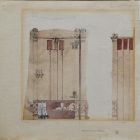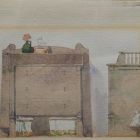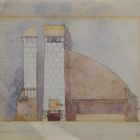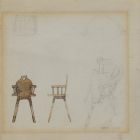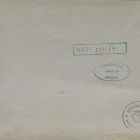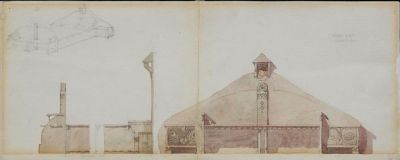
Design - bedroom furniture
| Accession Nr.: | KRTF 2171.1-7 |
|---|---|
| Artist/Maker: |
Kozma, Lajos (1884 - 1948) / designer |
| Date of production: |
1904 - 1906
|
| Place of production: | Budapest |
| Inscription: | jobbra lenn: KL |
|---|---|
| Materials: | paper |
| Techniques: | Indian ink; watercolour |
| Dimensions: |
height/width: 21,3 x 16,3 cm
height/width: 33 x 13,3 cm
height/width: 16 x 15 cm
height/width: 16,6 x 13,3 cm
height/width: 14,2 x 15,5 cm
height/width: 12,2 x 13 cm
height/width: 11,3 x 13 cm
|
These seven pages belong to the hardly known, early designs of Lajos Kozma, made while at university. It is an independent series of sketches, created partly under the influence of folkloric pieces but following the usual type of a middle-class bedroom. It proves Kozma's professional and graphic virtuosity with its refined watercolour technique and also documents the early roots of his designer activity. These sketches are connected to his secondary school years and the collection of relics of
folklore in Somogy county. They were modelled on the surveys of Károly Koós and other artists at the Gödöllő colony, but with a clear demand for functionality, resulting in a slightly eclectic style. Headboard carvings had been published in the periodical Magyar Iparművészet (Hungarian Applied Arts) from the first years of the century. Their influence can be detected on the relief decoration of the prismatic wardrobe, chest of drawers as well as on the column of the double bed. On the other hand
, the small chests that serve as night cupboards are decorated with decorative patches and applied motifs, similar to those on embroideries. The early trend of the excessive, wavy curves of Art Nouveau are reflected by the “stack-like” curve of the bed, the dressing table and the back support of the bench beside the tile stove. The closest inspirations are to be found in the furniture or interior designs of Ede Wigand, Sándor Nagy from Gödöllő, whose works were already present at exhibitions or
on photos. From 1904, folkloric motifs influenced not only the French and the Northern Art Nouveau, but also the generation educated on British Applied Arts - including Kozma. His later designs are more homogeneous, the various effects were united in his own individual style. The sketches could be dated on the basis of the signature and his contemporary publications. During his years at the Weiner family in Kaposvár, he met Rippl-Rónai, and modelled his own ’’emblem” on Rippl's typical signo of
his intials enframed by a curved, narrow line. In Kozma’s statuettes or ex libris pieces from 1905-1906, he used the same signature. Later, on the sketch of his Lapis refugii, before 1908 he changed for the geometrical, facing K and L letters in a prism. The relationship between the ornaments also supports the dating of this work of art. The peacock enamel, rhytmically repeated leaf motif and the lobed flower head on the belt buckle in the Budapest Museum of Applied Arts (see Cat. No. 9.184)
derive from the same source as the decoration of the chest-cupboards on the sketch. The belt buckle was exhibited at the 1905 Christmas exhibition, its picture published by the periodical Magyar Iparművészet (Hungarian Applied Arts), naming Lajos Kozma as the designer and Goitein M., a goldsmith at Kaposvár, as the maker.
Literature
- Somogyi Zsolt: A magyar szecesszió bútorművészete. Corvina Kiadó, Budapest, 2009. - Nr. 103.
- Szerk.: Szilágyi András, Horányi Éva: Szecesszió. A 20. század hajnala. (Az európai iparművészet korszakai.). Iparművészeti Múzeum, Budapest, 1996. - Nr. 9.245. (Lichner Magda)

